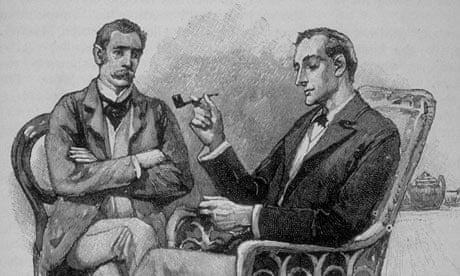Publishing trends have ebbed and flowed over the past century, but two genres have consistently flourished: tales of the supernatural and detective fiction. Put them together and you have, at least for me, a winning formula. What's not to like about a character with the foibles of a Holmes or a Poirot bringing their mighty powers of deduction to bear on creatures of the night? The sub-genre is at once a perfect fit (mooching about in dark, unsavoury places is second nature to the detective) and interestingly discordant (detectives deal in logic and facts, and ghosts, by their nature, move outside such things).
Sherlock Holmes did, of course, dabble in occult cases, his most famous being The Hound of the Baskervilles. But reason generally won out in the end and his supernatural mysteries usually turned out – like Scooby-Doo and the gang's adventures – to have a rational, criminal explanation. But there are plenty of detectives whose investigations don't return such earthbound conclusions, and for me the greatest is Thomas Carnacki.
Carnacki wasn't the first supernatural detective – that honour probably goes to Dr Martin Hesselius, created by Joseph Sheridan Le Fanu in the 1870s. But Carnacki, who first appeared in the Idler magazine in 1910, has all the elements in such perfect proportions that he deserves to be crowned king of the occult 'tecs – especially in this, his centenary year.
Carnacki was the creation of William Hope Hodgson, an author who had already gained literary renown for The Boats of the Glen Carrig and The House On the Borderland. The Carnacki stories always follow the same format: the great detective (I'm sure Holmes will excuse me appropriating his title for Carnacki in this instance) issues invitations to a group of friends to attend a dinner at his home at 427 Cheyne Walk, Chelsea. After a repast during which nothing is said of the story to come, Carnacki gathers them round to relate his latest adventure. The stories are narrated, Watson-like, by one of the crew: Dodgson, a man so close in name to the author that we can safely assume Hodgson was inserting himself into the stories.
The series appears under the name Carnacki the Ghost-Finder, and that's pretty much what he does. His reputation leads him to be invited to the rambling family piles of influential and moneyed types, to sort out the hauntings. What's especially refreshing is that, despite his experience, Carnacki is often as much of a scaredy-cat as the rest of us. In his first adventure, The Gateway of the Monster, he positively bottles it at going into a haunted room after dark.
And not all his cases turn out to be the work of the supernatural. Sometimes, just to keep things grounded, Hodgson throws in a pedestrian explanation – crooks trying to scare yokels away from a big house, for example. But when the case proves undeniably otherwordly, Carnacki finds cause to fight fire with fire: he draws himself and his helpers into pentacles and sigils to protect them against demonic incursions (see the truly terrifying sequence in The House Among the Laurels for a fine example).
The editors of the Idler obviously knew they'd struck gold with Carnacki, and on his third adventure, in their March 1910 edition, they printed a disclaimer with relish: "Complaints continue to reach us from all parts of the country to the effect that Mr W Hope Hodgson's Carnacki stories are producing a widespread epidemic of nervous prostration! So, far from being able to reassure or calm our nervous readers, we are compelled to warn them that The Whistling Room, which we publish this month, is worse than ever. Our advertising manager had to go to bed for two days after reading the advance sheets; a proofreader has sent in his resignation; and, worst of all, our smartest office boy … but this is no place to bewail or seek for sympathy!"
Carnacki's success spawned many more occult detectives, most notably Seabury Quinn's Jules de Grandin who appeared in Weird Tales for most of the second quarter of the last century. But who are the supernatural sleuths who deserve Carnacki's crown in the modern era? Urban fantasy is a flourishing sub-genre at the moment, and the private eye with one (gum)shoe in the grave is big business – Jim Butcher's Harry Dresden books have made the leap to TV, and F Paul Wilson's Repairman Jack has appeared in more than a dozen novels and even a series of spin-off Young Adult novels charting his teenage adventures.
For my money, though, the best of the current crop is Felix Castor, Mike Carey's trenchcoat-wearing exorcist who comes with a strong pedigree: Carey wrote the adventures of the comic world's greatest occult investigator, John Constantine. And just to prove that not all supernatural detectives are hard-boiled tough guys, the undisputed queens of the genre have to be Brenda and Effie, the women of a certain age who populate Paul Magrs' eye-popping version of Whitby.
Now, in the words with which Carnacki always brought his post-dinner tales to a close ... out you go!

Comments (…)
Sign in or create your Guardian account to join the discussion